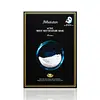What's inside
What's inside
 Key Ingredients
Key Ingredients

 Benefits
Benefits

 Concerns
Concerns

 Ingredients Side-by-side
Ingredients Side-by-side

Water
Skin ConditioningGlycerin
HumectantMethylpropanediol
SolventNiacinamide
SmoothingButylene Glycol
HumectantPhenoxyethanol
PreservativePEG-32
HumectantXanthan Gum
EmulsifyingErythritol
HumectantTrehalose
HumectantAllantoin
Skin ConditioningPolysorbate 20
EmulsifyingSnail Secretion Filtrate
Skin ConditioningHydroxyethylcellulose
Emulsion StabilisingDimethicone
EmollientEthylhexylglycerin
Skin Conditioning1,2-Hexanediol
Skin ConditioningDisodium EDTA
Sodium Polyacrylate
AbsorbentHydrogenated Lecithin
EmulsifyingDipotassium Glycyrrhizate
HumectantParfum
MaskingDisodium Phosphate
BufferingPolysorbate 60
EmulsifyingSodium Hyaluronate
HumectantSodium Phosphate
BufferingCI 15985
Cosmetic ColorantCI 16185
Cosmetic ColorantArtemisia Princeps Leaf Extract
Skin ConditioningCalendula Officinalis Extract
Skin ConditioningFolic Acid
Skin ConditioningPyridoxine
Skin ConditioningRiboflavin
Cosmetic ColorantThiamine Hcl
MaskingMenadione
MaskingBiotin
AntiseborrhoeicCyanocobalamin
Skin ConditioningGlucose
HumectantHyaluronic Acid
HumectantHydrolyzed Hyaluronic Acid
HumectantPanthenol
Skin ConditioningAscorbic Acid
AntioxidantBioflavonoids
Skin ConditioningGlutathione
Tocopheryl Acetate
AntioxidantWater, Glycerin, Methylpropanediol, Niacinamide, Butylene Glycol, Phenoxyethanol, PEG-32, Xanthan Gum, Erythritol, Trehalose, Allantoin, Polysorbate 20, Snail Secretion Filtrate, Hydroxyethylcellulose, Dimethicone, Ethylhexylglycerin, 1,2-Hexanediol, Disodium EDTA, Sodium Polyacrylate, Hydrogenated Lecithin, Dipotassium Glycyrrhizate, Parfum, Disodium Phosphate, Polysorbate 60, Sodium Hyaluronate, Sodium Phosphate, CI 15985, CI 16185, Artemisia Princeps Leaf Extract, Calendula Officinalis Extract, Folic Acid, Pyridoxine, Riboflavin, Thiamine Hcl, Menadione, Biotin, Cyanocobalamin, Glucose, Hyaluronic Acid, Hydrolyzed Hyaluronic Acid, Panthenol, Ascorbic Acid, Bioflavonoids, Glutathione, Tocopheryl Acetate
Water
Skin ConditioningGlycerin
HumectantAlcohol
AntimicrobialHydroxyethylcellulose
Emulsion StabilisingPolysorbate 80
EmulsifyingBetaine
HumectantCentella Asiatica Extract
CleansingHamamelis Virginiana Extract
AntiseborrhoeicCamellia Sinensis Extract
AntioxidantCitrus Nobilis Peel Extract
MaskingCeramide NP
Skin ConditioningSodium Hyaluronate
HumectantCarbomer
Emulsion StabilisingTriethanolamine
BufferingDisodium EDTA
Phenoxyethanol
PreservativeAroma
Ingredients Explained
These ingredients are found in both products.
Ingredients higher up in an ingredient list are typically present in a larger amount.
Disodium EDTA plays a role in making products more stable by aiding other preservatives.
It is a chelating agent, meaning it neutralizes metal ions that may be found in a product.
Disodium EDTA is a salt of edetic acid and is found to be safe in cosmetic ingredients.
Learn more about Disodium EDTAGlycerin is already naturally found in your skin. It helps moisturize and protect your skin.
A study from 2016 found glycerin to be more effective as a humectant than AHAs and hyaluronic acid.
As a humectant, it helps the skin stay hydrated by pulling moisture to your skin. The low molecular weight of glycerin allows it to pull moisture into the deeper layers of your skin.
Hydrated skin improves your skin barrier; Your skin barrier helps protect against irritants and bacteria.
Glycerin has also been found to have antimicrobial and antiviral properties. Due to these properties, glycerin is often used in wound and burn treatments.
In cosmetics, glycerin is usually derived from plants such as soybean or palm. However, it can also be sourced from animals, such as tallow or animal fat.
This ingredient is organic, colorless, odorless, and non-toxic.
Glycerin is the name for this ingredient in American English. British English uses Glycerol/Glycerine.
Learn more about GlycerinHydroxyethylcellulose is used to improve the texture of products. It is created from a chemical reaction involving ethylene oxide and alkali-cellulose. Cellulose is a sugar found in plant cell walls and help give plants structure.
This ingredient helps stabilize products by preventing ingredients from separating. It can also help thicken the texture of a product.
This ingredient can also be found in pill medicines to help our bodies digest other ingredients.
Learn more about HydroxyethylcellulosePhenoxyethanol is a preservative that has germicide, antimicrobial, and aromatic properties. Studies show that phenoxyethanol can prevent microbial growth. By itself, it has a scent that is similar to that of a rose.
It's often used in formulations along with Caprylyl Glycol to preserve the shelf life of products.
Sodium Hyaluronate is hyaluronic acid's salt form. It is commonly derived from the sodium salt of hyaluronic acid.
Like hyaluronic acid, it is great at holding water and acts as a humectant. This makes it a great skin hydrating ingredient.
Sodium Hyaluronate is naturally occurring in our bodies and is mostly found in eye fluid and joints.
These are some other common types of Hyaluronic Acid:
Learn more about Sodium HyaluronateWater. It's the most common cosmetic ingredient of all. You'll usually see it at the top of ingredient lists, meaning that it makes up the largest part of the product.
So why is it so popular? Water most often acts as a solvent - this means that it helps dissolve other ingredients into the formulation.
You'll also recognize water as that liquid we all need to stay alive. If you see this, drink a glass of water. Stay hydrated!
Learn more about Water